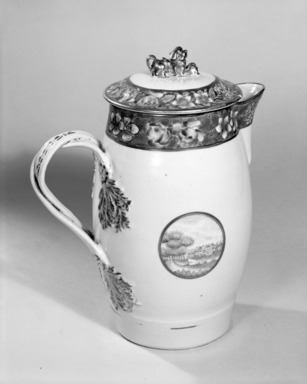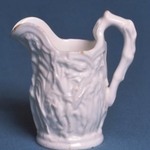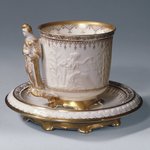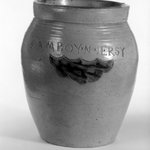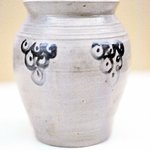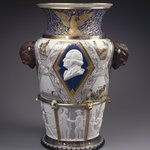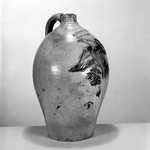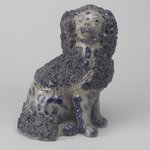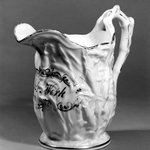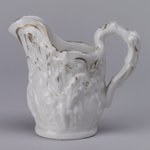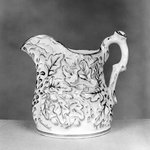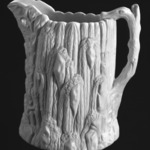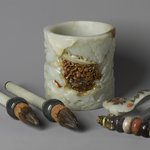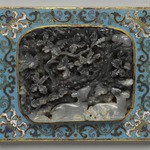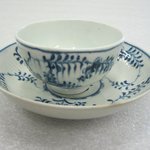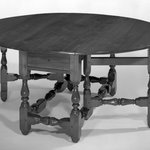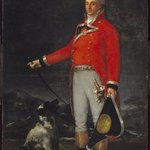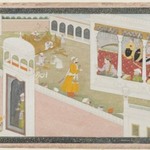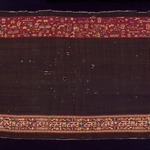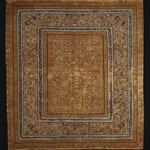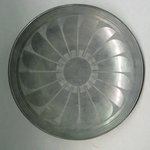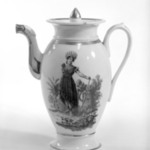

Jug, 1800-1810. Porcelain, Height: 10 1/4 in. (26 cm). Brooklyn Museum, Gift of the Wyckoff Family, 41.1212a-b. Creative Commons-BY (Photo: Brooklyn Museum, 41.1212_PS6.jpg)
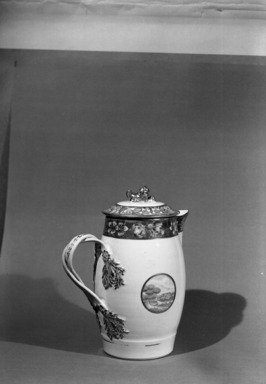
Jug, 1800-1810. Porcelain, Height: 10 1/4 in. (26 cm). Brooklyn Museum, Gift of the Wyckoff Family, 41.1212a-b. Creative Commons-BY (Photo: Brooklyn Museum, 41.1212A-B_acetate_bw.jpg)
Jug
Decorative Arts and Design
VESSELS FOR CHOCOLATE
In New Spain and in the Caribbean, chocolate was the preferred elite beverage. An Italian traveler in the late eighteenth century noted that “all over the kingdom of Mexico it is the practice to drink chocolate twice a day.... The first [time] is early in the morning—many times they drink it in bed. The second time it is taken is around [4 p.m.].”
Before the conquest, chocolate, an American product then unknown to Europeans, was a foamy, bitter combination of cacao and water, mixed with achiote for color, chili peppers for spice, and wild honey for sweetness. The Spanish were the first to sweeten the drink with sugar.
Chocolate was accompanied by pieces of sweet bread and pastries for dipping and served in elaborate containers such as double-handled bernegales (see illustration), silver-mounted coconut shells, and jícaras (chocolate cups) with their corresponding mancerinas (saucers). The costly ingredients used to prepare chocolate were secured in special jars with iron or silver locks and kept under the watch of the lady of the house.
Chocolate, imported from Mexico, was very expensive in colonial British America. The wealth of Brooklyn’s Wyckoff family in the early 1800s is suggested by their purported use of a cider jug (on view here) as a chocolate pot.
VASIJAS PARA CHOCOLATE
En la Nueva España y el Caribe, el chocolate era la bebida preferida de la élite. Un viajero italiano a fines del siglo XVIII menciona que “por todo el reino de México es práctica el beber el chocolate dos veces al día.... La primera [vez] es temprano por la mañana–muchas veces lo beben en la cama. La segunda vez se toma alrededor [de las 4 pm].”
Antes de la conquista, el chocolate, un producto americano desconocido por los europeos, era una bebida espumosa y amarga hecha con cacao y agua, mezclada con achiote para darle color, con ají para especiarla y con miel silvestre para darle dulzor. Los españoles fueron los primeros en endulzar la bebida con azúcar.
El chocolate se acompañaba con pedazos de pan dulce y pasteles para remojar y se servía en elaborados recipientes como los bernegales de doble asa (ver ilustración), nueces de coco montadas en plata y jícaras (tazas de chocolate) con sus correspondientes mancerinas (platillos). Los costosos ingredientes usados para preparar chocolate se guardaban en jarros especiales con cerraduras de hierro o de plata y se mantenían bajo la custodia de la señora de la casa.
El chocolate era sumamente costoso en la América colonial británica, ya que tenia que importarse de México. La riqueza de la familia Wyckoff de Brooklyn a principios del siglo XIX se ponía en evidencia por el empleo de una gran jarra de sidra (mostrada aquí) para chocolate.
In New Spain and in the Caribbean, chocolate was the preferred elite beverage. An Italian traveler in the late eighteenth century noted that “all over the kingdom of Mexico it is the practice to drink chocolate twice a day.... The first [time] is early in the morning—many times they drink it in bed. The second time it is taken is around [4 p.m.].”
Before the conquest, chocolate, an American product then unknown to Europeans, was a foamy, bitter combination of cacao and water, mixed with achiote for color, chili peppers for spice, and wild honey for sweetness. The Spanish were the first to sweeten the drink with sugar.
Chocolate was accompanied by pieces of sweet bread and pastries for dipping and served in elaborate containers such as double-handled bernegales (see illustration), silver-mounted coconut shells, and jícaras (chocolate cups) with their corresponding mancerinas (saucers). The costly ingredients used to prepare chocolate were secured in special jars with iron or silver locks and kept under the watch of the lady of the house.
Chocolate, imported from Mexico, was very expensive in colonial British America. The wealth of Brooklyn’s Wyckoff family in the early 1800s is suggested by their purported use of a cider jug (on view here) as a chocolate pot.
VASIJAS PARA CHOCOLATE
En la Nueva España y el Caribe, el chocolate era la bebida preferida de la élite. Un viajero italiano a fines del siglo XVIII menciona que “por todo el reino de México es práctica el beber el chocolate dos veces al día.... La primera [vez] es temprano por la mañana–muchas veces lo beben en la cama. La segunda vez se toma alrededor [de las 4 pm].”
Antes de la conquista, el chocolate, un producto americano desconocido por los europeos, era una bebida espumosa y amarga hecha con cacao y agua, mezclada con achiote para darle color, con ají para especiarla y con miel silvestre para darle dulzor. Los españoles fueron los primeros en endulzar la bebida con azúcar.
El chocolate se acompañaba con pedazos de pan dulce y pasteles para remojar y se servía en elaborados recipientes como los bernegales de doble asa (ver ilustración), nueces de coco montadas en plata y jícaras (tazas de chocolate) con sus correspondientes mancerinas (platillos). Los costosos ingredientes usados para preparar chocolate se guardaban en jarros especiales con cerraduras de hierro o de plata y se mantenían bajo la custodia de la señora de la casa.
El chocolate era sumamente costoso en la América colonial británica, ya que tenia que importarse de México. La riqueza de la familia Wyckoff de Brooklyn a principios del siglo XIX se ponía en evidencia por el empleo de una gran jarra de sidra (mostrada aquí) para chocolate.
MEDIUM
Porcelain
DATES
1800-1810
PERIOD
Jiaqing Period
DIMENSIONS
Height: 10 1/4 in. (26 cm)
Diameter of base: 4 1/4 in. (10.8 cm) (show scale)



MARKINGS
Under spout (in script, in gold): "F.W."
COLLECTIONS
Decorative Arts and Design
ACCESSION NUMBER
41.1212a-b
CREDIT LINE
Gift of the Wyckoff Family
CATALOGUE DESCRIPTION
Cider jug (a); barrel-shaped body, with separate cover (b). Cross-strapped handle attached to body with leaf decoration. Circular sepia medallion on each side of center body showing architectural view, polychrome floral and fruit bands on upper part of body and on lid. Gilded lion finial. Gilded ground.
CONDITION: Chipped.
MUSEUM LOCATION
This item is not on view
CAPTION
Jug, 1800-1810. Porcelain, Height: 10 1/4 in. (26 cm). Brooklyn Museum, Gift of the Wyckoff Family, 41.1212a-b. Creative Commons-BY (Photo: Brooklyn Museum, 41.1212_PS6.jpg)
IMAGE
overall, 41.1212_PS6.jpg. Brooklyn Museum photograph, 2013
"CUR" at the beginning of an image file name means that the image was created by a curatorial staff member. These study images may be digital point-and-shoot photographs, when we don\'t yet have high-quality studio photography, or they may be scans of older negatives, slides, or photographic prints, providing historical documentation of the object.
RIGHTS STATEMENT
Creative Commons-BY
You may download and use Brooklyn Museum images of this three-dimensional work in accordance with a Creative Commons license. Fair use, as understood under the United States Copyright Act, may also apply.
Please include caption information from this page and credit the Brooklyn Museum. If you need a high resolution file, please fill out our online application form (charges apply).
For further information about copyright, we recommend resources at the United States Library of Congress, Cornell University, Copyright and Cultural Institutions: Guidelines for U.S. Libraries, Archives, and Museums, and Copyright Watch.
For more information about the Museum's rights project, including how rights types are assigned, please see our blog posts on copyright.
If you have any information regarding this work and rights to it, please contact copyright@brooklynmuseum.org.
RECORD COMPLETENESS
Not every record you will find here is complete. More information is available for some works than for others, and some entries have been updated more recently. Records are frequently reviewed and revised, and we welcome any additional information you might have.
